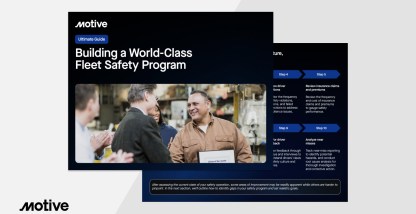Safety managers can improve fleet safety by identifying at-risk drivers, setting up safety standards, driver training, and using dash cams.
The average cost of all large truck collisions is about $91,000 per crash. In the case of fatalities, that amount jumps up to $3.6 million. One such accident has the potential to shut down a trucking business.
As fleet and safety managers, you already know the importance of road safety. Monitoring drivers for poor driving practices and then initiating driver coaching programs is the only way to maximize road safety and reduce the number of incidents that may cripple your business.
Motive offers you all the necessary tools that you need to:
- Set up critical safety events
- Identify drivers with risky driving habits
- Easily manage driver coaching programs
- Improve the overall safety level of your fleet
Let’s see how.
Set up safety thresholds
The safety event threshold determines the minimum intensity of hard accelerations or hard braking events that is required to trigger a critical safety event. These events then contribute to a driver’s safety score.
Motive allows you to customize these safety thresholds for any of your vehicles.
The idea is to offer a customizable setup that allows fleets to set up their own safety standards. Fleets can increase their safety levels by setting up lower safety thresholds as drivers improve their driving skills.
It is important to get experienced drivers and safety managers on board when setting up triggers for safety events. Not only will it help with setting the direction and the overall strategy, but collaborating with drivers may also help with driver happiness and retention.
For a step-by-step guide, read this support article on how to set up safety thresholds.
Identify your best- and worst-performing drivers
Once you have set up safety thresholds, it is time to identify your best- and worst-performing drivers. The Motive Dashboard offers that information readily.
Drivers are ranked according to their driving performance. Driver safety scores are calculated after considering all the critical safety events, such as hard braking, hard cornering, and excessive acceleration.
Apart from the total safety scores, you can also track each critical safety event (hard braking, cornering, and acceleration) as well as the total miles for each driver. This can help you calculate how to determine your event triggers to maintain driver safety.
Easily manage safety events with driver coaching
Once you have identified the drivers with the worst driver safety scores, you can initiate driver coaching programs.
We recently introduced the Driver Coaching feature, which simplifies the way fleet and safety administrators manage safety events and driver coaching programs.
After identifying high-risk drivers and the safety events, mark them with one of the following statuses:
- Pending review: new events, awaiting review
- Coachable: events that require coaching
- Coached: events where you have talked to the driver
- Uncoachable: events that do not require any further action
Learn more about driver coaching to see how it may help simplify driver training programs.
Dash cams, the other part of the puzzle
If you want to remove guesswork completely, you can install the Motive Smart Dashcam to see exactly what happens during a critical safety event.
Norman Bright, Fleet and Safety Manager at Woodford Oil, recently installed the Motive Smart Dashcam in all 50 vehicles the company has. He says:
“I highly recommend everyone have a forward-facing camera. It’s really for safety, training and the ability to see what goes on during an event. That has been priceless for us.”
Once you connect the Motive Smart Dashcam with the Motive ELD, they integrate seamlessly. It means whenever the ELD detects a critical safety event the Smart Dashcam records 10 seconds of HD video before and after the event. The video is then immediately sent to the Motive Dashboard for real-time viewing.
By seeing the road from the driver’s perspective, you can customize your safety thresholds and improve your driver training programshttps://gomotive.com/blog/build-coaching-fleet-safety-program/.
With video, conversations with drivers are based on evidence, not incomplete information. You can show them exactly what happened and why as well as how to avoid a similar incident in the future.
See how our Smart Dashcam works.
Improve fleet safety by monitoring and managing safety events
Improving road safety is a high priority for most fleets.
Setting up safety events and identifying high-risk drivers is the first step to achieving that goal. Upgrade to Motive ELD Pro to get access to driver safety scorecards and several other features, such as idle-time tracking, vehicle diagnostics, and IFTA fuel tax reporting.









